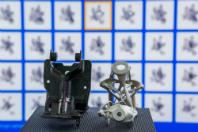GM Lightens up One Gram at a Time

General Motors Lightens up One Gram at a Time
Did you know that General Motors applies lightweighting principles to all its vehicles, whether they’re EVs, trucks, high-performance vehicles or beyond? The Chevrolet Camaro alone lost almost 400 pounds back in 2016 thanks to lightweighting efforts.
So why is this important? Because less weight translates to emissions savings. Newton's second law of motion states that the heavier an object, the more force is required to move it. Emissions can be greatly affected by the weight of the vehicles we produce, which is why lightweighting is an especially essential element on our journey toward a zero emissions future.
GM’s global vehicle mass integration and strategy team works collaboratively across the business to produce the most mass-efficient vehicles possible. We achieve this in several ways, from consolidating the number of parts for a given system, to inventing advanced joining methods for aluminum and high-strength steels.
“We are able to work with a broad material selection and utilize the manufacturing tools and technologies to ‘put the right material in the right place’ while designing a vehicle around a specific customer type,” said Rob Peckham, GM global mass vehicle performance owner.
And the combined efforts are working. Since 2016, we’ve removed more than 5,000 pounds collectively from 14 vehicles, saving consumers 35 million gallons of fuel and reducing CO2 emissions by around 312,000 metric tons per year — showing that extraordinary strides toward zero emissions can come from across our product lineup.
Take the all-new 2019 GMC Sierra Denali, which will ultimately feature an available GMC exclusive and industry-first carbon fiber box — the CarbonPro — developed to increase durability, efficiency and functionality of the truck. It replaces the standard steel inner panels and floor with a lightweight, purpose-designed carbon fiber composite that offers best-in-class dent, scratch and corrosion resistance.
This new CarbonPro box is 62 pounds lighter than the steel version, and is one example of our strategic use of materials in engineering the Sierra. Our approach also incorporates aluminum for the doors, hood and tailgate, while relying on steel for the fenders, roof and standard cargo box to shave up to 360 pounds from the prior model.
Perhaps even more exciting are the possibilities with generative design and additive manufacturing (3D printing), which we call “lightweighting 2.0.” This approach removes many of the traditional manufacturing constraints involved with casting and stamping when creating vehicle components. For example, instead of creating a mold or tool to make a part, a 3D printer can print the part directly. The design freedom offered by 3D printing allows us to manufacture lightweight, optimized part designs that often could not be produced using conventional manufacturing.
GM is the first automaker in North America to use a new, generative design software that employs cloud computing and AI-based algorithms to rapidly explore multiple permutations of a part design. The software allows a user to set various goals and parameters based on weight, strength, material choice, fabrication method and other factors to determine the best design option for a given vehicle part. GM engineers will be able to explore hundreds of ready-to-be manufactured, high-performance design options faster than we were able to validate a single design the old way.
When paired with manufacturing advancements, such as 3D printing, we can transform the vehicle development process. The result will be significant vehicle mass reduction and greater parts consolidation opportunities than could be achieved through traditional design optimization methods.
We, along with partner Autodesk, who developed the software, have applied this technology to produce a proof-of-concept part—a seat bracket. The technology consolidates eight separately stamped and welded sheet metal parts into one single 3D-printed part, which not only reduced its mass by 40 percent but also made it 20 percent stronger than the original part. As part of a multiyear alliance focused on innovation, GM and Autodesk plan to collaborate on projects involving generative design, additive manufacturing and materials science.
“The results are very promising,” said Ali Shabbir, GM product application engineer, Additive Design and Manufacturing. “This process gives us multiple design options to consider and rapidly iterate, which I believe is a key enabler to future alternative propulsion vehicles.”
Lightweighting through advanced materials and optimization tools are major steps on our path to zero crashes, zero emissions and zero congestion. To learn more about GM’s lightweighting efforts and efficient fundamentals see gmsustainabiliy.com.

